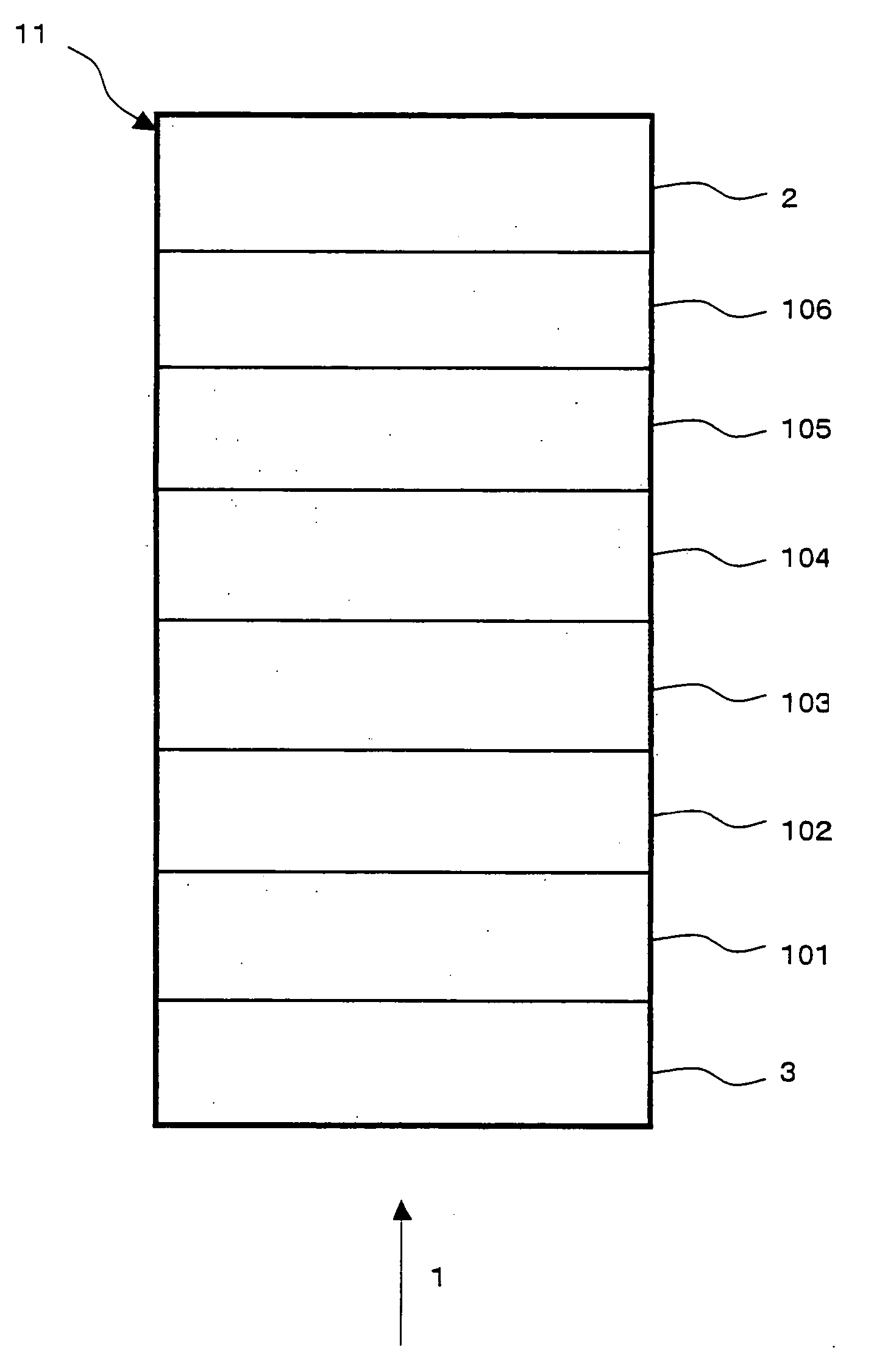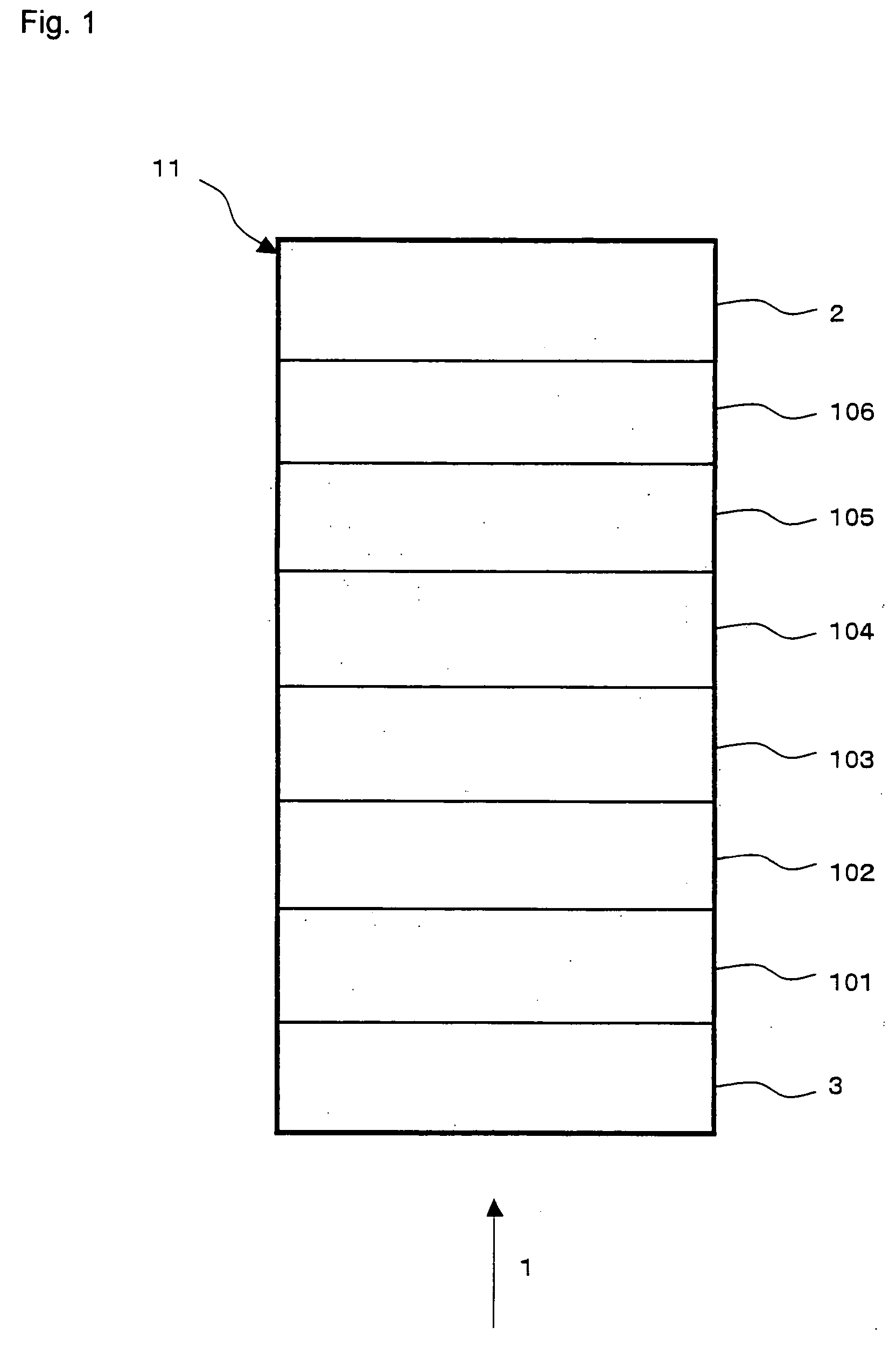Information recording medium and manufacturing method thereof
a technology of information recording medium and manufacturing method, which is applied in the field of information recording medium, can solve the problems of reducing the crystallization speed of the recording layer
- Summary
- Abstract
- Description
- Claims
- Application Information
AI Technical Summary
Benefits of technology
Problems solved by technology
Method used
Image
Examples
embodiment 1
[0056] Embodiment 1 explains one example of an information recording medium of the present invention. FIG. 1 shows a partial cross-sectional view of an information recording medium 11 of Embodiment 1. This information recording medium 11 is an optical information recording medium that is capable of recording and reproducing information through irradiation with a laser beam 1.
[0057] The information recording medium 11 is constituted by a reflective layer 106, a second dielectric layer 105, a second interface layer 104, a recording layer 103, a first interface layer 102, a first dielectric layer 101 and a transparent layer 3 that are successively laminated on a substrate 2.
[0058] Since the laser beam 1 is made incident on the side of a transparent layer 3 and light reflected from the recording layer 103 is utilized as a reproducing signal, the transparent layer 3, placed on the light incident side of the recording layer 103, is preferably made to have little light absorbing property...
embodiment 2
[0097] Embodiment 2 explains one example of an information recording medium of the present invention. FIG. 4 shows a partial cross-sectional view of an information recording medium 14 of Embodiment 2. This information recording medium 14 is a multilayer optical information recording medium that is capable of recording and reproducing information through irradiation of a laser beam 1 from one side of the faces.
[0098] The information recording medium 14 is constituted by N sets (N is a natural number satisfying N≧2) of layers, that is, the N information layer 36, the (N−1) information layer 34, the first information layer 31 and the transparent layer 3, which are successively laminated on the substrate 2 through optical separation layers 35, 33, 32, etc. Those information layers up to the (N−1)-numbered layer counted from the light incident side of the laser beam 1 and those information layers from the first information layer 31 to the (N−1) information layer 34 (hereinafter, the N-n...
embodiment 3
[0137] Embodiment 3 explains one example of an information recording medium in which, N=2 holds in the multilayer optical information recording medium of Embodiment 2 in the present invention, that is, a structure in which the information recording medium is constituted by two sets of information layers. FIG. 7 shows one portion of a cross-sectional view of the information recording medium 17 of Embodiment 3. The information recording medium 17 is a two-layered optical information recording medium 14 that is capable of recording and reproducing information through irradiation of a laser beam 1 from one side of the faces.
[0138] The information recording medium 17 is constituted by a second information layer 41, an optical separation layer 32, a first information layer 31 and a transparent layer 3 that are successively laminated on the substrate 2. With respect to the substrate 2, the optical separation layer 32, the first information layer 31 and the transparent layer 3, the same ma...
PUM
 Login to View More
Login to View More Abstract
Description
Claims
Application Information
 Login to View More
Login to View More - R&D
- Intellectual Property
- Life Sciences
- Materials
- Tech Scout
- Unparalleled Data Quality
- Higher Quality Content
- 60% Fewer Hallucinations
Browse by: Latest US Patents, China's latest patents, Technical Efficacy Thesaurus, Application Domain, Technology Topic, Popular Technical Reports.
© 2025 PatSnap. All rights reserved.Legal|Privacy policy|Modern Slavery Act Transparency Statement|Sitemap|About US| Contact US: help@patsnap.com



